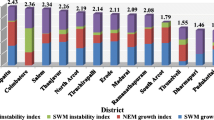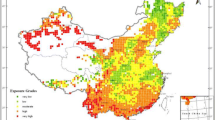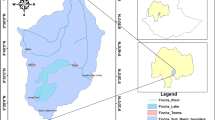Abstract
Agriculture is one of the most vulnerable sectors to climate change. The current vulnerability assessments through traditional fragmented sectoral methods are insufficient to capture the effects on complex agricultural systems. Therefore, the traditional methods need to be replaced by integrated approaches. The objective of this study is to propose a holistic vulnerability assessment method for agricultural systems. By aggregating both agro-ecological and socio-economic information, we develop an agricultural systems vulnerability index (ASVI) which allows for (i) a classification of geographical units according to their vulnerability level, (ii) an identification of key determinants of vulnerability for each unit and (iii) an assessment of adaptation policy scenarios considering their effects on the sustainability of the analysed systems. The proposed method is applied in the Khorezm region of Uzbekistan—a representative irrigated agricultural region in the lower Amu Darya river basin. A decision support tool is used to facilitate multi-criteria decision analysis, including the computation of the index and performing sensitivity analysis of the results. The assessment for Khorezm reveals significant spatial differences of vulnerability levels due to a variation of contributing factors, e.g. natural resources, water productivity, rural-urban ratio. It reveals also that feasible land and water management policies could reduce the vulnerability in Khorezm, particularly in the districts with the poorest agro-ecological conditions. Overall, the proposed method could support national and local authorities in the identification of sustainable adaptation policies for the agriculture sector.







Similar content being viewed by others
Notes
The most critical criterion is part of the sensitivity analysis performed in mDSS software. It shows the criterion that could reverse the ranking of the options given the smallest change in its weight.
References
Adger WN, Arnell NW, Tompkins E (2005) Successful adaptation to climate change across scales. Glob Environ Chang 15:77–86
Akramkhanov A, Kuziev R, Sommer R, Martius C, Forkutsa O, Massucati L (2012) Soils and soil ecology in Khorezm. In: Martius C, Rudenko I, Lamers JPA, Vlek PLG (eds) Cotton, water, salts and soums: economic and ecological restructuring in Khorezm, Uzbekistan. Springer, Netherlands
Aleksandrova M, Lamers JPA, Martius C, Tischbein B (2014) Rural vulnerability to environmental change in the irrigated lowlands of Central Asia and options for policy-makers: a review. Environ Sci Pol 41:77–88
Antwi-Agyei P, Fraser EDG, Dougill AJ, Stringer LC, Simelton E (2012) Mapping the vulnerability of crop production to drought in Ghana using rainfall, yield and socioeconomic data. Appl Geogr 32(2):324–334
Awan UK, Tischbein B, Kamalov P, Martius C, Hafeez M (2012) Modeling irrigation scheduling under shallow groundwater conditions as a tool for an integrated management of surface and groundwater resources. In: Martius C, Rudenko I, Lamers JPA, Vlek PLG (eds) Cotton, water, salts and soums: economic and ecological restructuring in Khorezm, Uzbekistan. Springer, Netherlands
Balbi S, Bhandari S, Gain AK, Giupponi C (2013) Multi-agent agro-economic simulation of irrigation water demand with climate services for climate change adaptation. Ital J Agron 8(3):175–185. doi:10.4081/ija.2013.e23
Banerjee S, Das S, Mukherjee A, Mukherjes A, Saikia B (2014) Adaptation strategies to combat climate change effect on rice and mustard in Eastern India. Mitig Adapt Strategr Glob Chang. doi:10.1007/s11027-014-9595-y
Bekchanov M, Karimov A, Lamers JPA (2010) Impact of water availability on land and water productivity: a temporal and spatial analysis of the case study region Khorezm, Uzbekistan. Water 2(3):668–684, Special Issue: Challenges and Developments on Water Resources Management in Central Asia
Berry PM, Rounsevell MDA, Harrison PA, Audsley E (2006) Assessing the vulnerability of agricultural land use and species to climate change and the role of policy in facilitating adaptation. Environ Sci Pol 9(2):189–204
Biesbroek GR, Swart RJ, Carter TR, Cowan C, Henrichs T, Mela H, Morecroft MD, Rey D (2010) Europe adapts to climate change: comparing national adaptation strategies. Glob Environ Chang 20:440–450
Birkmann J (2006a) Indicators and criteria for measuring vulnerability: theoretical bases and requirements. In: Birkmann J (Ed.) Measuring vulnerability to natural hazards: towards disaster resilient societies. United Nations University Press
Birkmann J (2006b) Measuring vulnerability to promote disaster-resilient societies: conceptual frameworks and definitions. In: Birkmann J (Ed.) Measuring vulnerability to natural hazards: towards disaster resilient societies. United Nations University Press
Birkmann J, Cardona OD, Carreño ML, Barbat AH, Pelling M, Schneiderbauer S, Kienberger S, Keiler M, Alexander D, Zeil P, Welle T (2013) Framing vulnerability, risk and societal responses: the MOVE framework. Nat Hazards, vol 67, 2nd edn. Springer, Netherlands, pp 193–211
Bobojonov I, Lamers JPA, Djanibekov N, Ibragimov N, Begdullaeva T, Ergashev A-K, Kienzler K, Eshchanov R, Rakhimov A, Ruzimov J, Martius C (2012) Crop diversification in support of sustainable agriculture in Khorezm. In: Martius C, Rudenko I, Lamers JPA, Vlek PLG (eds) Cotton, water, salts and soums: economic and ecological restructuring in Khorezm, Uzbekistan. Springer, Netherlands
Calzadilla A, Zhu T, Rehdanz K, Tol RSJ, Ringler C (2013) Economy-wide impacts of climate change on agriculture in sub-Saharan Africa. Ecol Econ 93:150–165
Conway D, Mustelin J (2014) Strategies for improving adaptation practice in developing countries. Nat Clim Chang 4(5):339–342
Djanibekov N, Frohberg K, Djanibekov U (2013a) Income-based projections of water footprint of food consumption in Uzbekistan. Glob Planet Chang 110(Part A):130–142
Djanibekov U, Djanibekov N, Khamzina A, Bhaduri A, Lamers JPA, Berg E (2013b) Impacts of innovative forestry land use on rural livelihood in a bimodal agricultural system in irrigated drylands. Land Use Policy 35:95–106
Dubovyk O, Menz G, Conrad C, Kan E, Machwitz M, Khamzina A (2012) Spatio-temporal analyses of cropland degradation in the irrigated lowlands of Uzbekistan using remote-sensing and logistic regression modeling. Environ Monit Assess 185(6):4775–4790
Eriksen SH, Kelly PM (2007) Developing credible vulnerability indicators for climate adaptation policy assessment. Mitig Adapt Strateg Glob Chang 12(4):495–524
Fekete A, Damm M, Birkmann J (2010) Scales as a challenge for vulnerability assessment. Nat Hazards 55(3):729–747
Füssel H-M (2007) Vulnerability: a generally applicable conceptual framework for climate change research. Glob Environ Chang 17(2):155–167
Füssel H-M, Klein RJT (2006) Climate change vulnerability assessments: an evolution of conceptual thinking. Clim Chang 75(3):301–329
Gain A, Wada Y (2014) Assessment of future water scarcity at different spatial and temporal scales of the Brahmaputra river basin. Water Resour Manag 28(4):999–1012
Gain AK, Giupponi C (2015) A dynamic assessment of water scarcity risk in the lower Brahmaputra river basin: an integrated approach. Ecol Indic 48:120–131
Gain AK, Giupponi C, Renaud FG (2012) Climate change adaptation and vulnerability assessment of water resources systems in developing countries: a generalized framework and a feasibility study in Bangladesh. Water 4(2):345–366
Giupponi C (2007) Decision support systems for implementing the European water framework directive: the MULINO approach. Environ Model Softw 22(2):248–258
Giupponi C (2014) Decision support for mainstreaming climate change adaptation in water resources management. Water Resour Manag 28(13):4795–4808
Giupponi C, Carpani M (2006) Recent developments in indicators and models for agri-environmental assessment. Ital J Agron 1(4):647–664
Giupponi C, Giove S, Giannini V (2013) A dynamic assessment tool for exploring and communicating vulnerability to floods and climate change. Environ Model Softw 44:136–147
Giupponi C, Mojtahed V, Gain AK, Biscaro C, Balbi S (2015) Integrated risk assessment of water-related disasters. In: Shroder JF, Paron P, Baldassarre GD (eds) Hydro-Meteorological Hazards, Risks and Disasters, Elsevier, Boston, Chapter 6, 163-200. doi: 10.1016/B978-0-12-394846-5.00006-0
Giupponi C, Sgobbi A, Mysiak J, CameraR, Fassio A (2008) NetSyMoD: an integrated approach for water resources management. In: Maire P, Coenen M, Lombardo C, Robba M, Sacile R (eds) Integrated water management: practical experiences and case studies. Springer
Harvey A, Hinkel J, Horrocks L, Klein R, Lasage R, Hodgson N, Sajwaj T, Benize M (2008) Preliminary assessment and roadmap for the elaboration of climate change vulnerability indicators at regional level. European Commission
Harvey CA, Rakotobe ZL, Rao NS, Dave R, Razafimahatratra H, Rabarijohn RH, Rajaofara H, MacKinnon JL (2014) Extreme vulnerability of smallholder farmers to agricultural risks and climate change in Madagascar. Philos Trans Royal Soc B. 369(1639)
Hinkel J (2011) “Indicators of vulnerability and adaptive capacity”: towards a clarification of the science–policy interface. Glob Environ Chang 21(1):198–208
Howden SM, Soussana JF, Tubiello FN, Chhetri N, Dunlop M, Meinke H (2007) Adapting agriculture to climate change. PNAS 104:19691–19696
Hulme M, O’Neill SJ, Dessai S (2011) Is weather event attribution necessary for adaptation funding? Science 334(6057):764–765
IPCC (2012) Managing the risks of extreme events and disasters to advance climate change adaptation. In: Field CB, Barros V, Stocker TF, Qin D, Dokken DJ, Ebi KL, Mastrandrea MD, Mach KJ, Plattner G-K, Allen SK, Tignor M, Midgley PM (eds) A special report of working groups I and II of the intergovernmental panel on climate change. Cambridge University Press, Cambridge, p 582
IPCC (2014) Glossary of terms (Final draft). In: Climate change 2014: impacts, adaptation, and vulnerability. Contribution of working group II to the Fifth Assessment Report of the Intergovernmental Panel on Climate Change. http://www.ipcc.ch/report/ar5/wg2/. Cited 26 June 2014
IPCC (2014b) Summary for policymakers. In: climate change 2014: impacts, adaptation, and vulnerability. In: Field CB, Barros VR, Dokken DJ, Mach KJ, Mastrandrea MD, Bilir TE, Chatterjee M, Ebi KL, Estrada YO, Genova RC, Girma B, Kissel ES, Levy AN, MacCracken S, Mastrandrea PR, White LL (eds) Part A: global and sectoral aspects. Contribution of working group II to the fifth assessment report of the intergovernmental panel on climate change. Cambridge University Press, Cambridge
Karimov A (2012) An economic efficiency analysis of crop producing farms in Uzbekistan: explanatory factors and estimation techniques. Dissertation. Rheinischen Friedrich-Wilhelms-Universitat, Bonn, Germany
Khamzina A, Lamers JPA, Vlek PLG (2012) Conversion of degraded cropland to tree plantations for ecosystem and livelihood benefits. In: Martius C, Rudenko I, Lamers JPA, Vlek PLG (eds) Cotton, water, salts and soums: economic and ecological restructuring in Khorezm, Uzbekistan. Springer, Netherlands
Laboda TV (2014) Adaptation strategies to climate change in the Arctic: a global patchwork of reactive community-scale initiatives. Environ Res Lett 9:111006. doi:10.1088/1748-9326/9/11/111006
Lindoso D, Rocha J, Debortoli N, Parente I, Eiró F, Bursztyn M, Rodrigues-Filho S (2014) Integrated assessment of smallholder farming’s vulnerability to drought in the Brazilian semi-arid: a case study in Ceará. Clim Chang 127(1):93–105
Liu X, Zhang J, Ma D, Bao Y, Tong Z, Liu X (2013) Dynamic risk assessment of drought disaster for maize based on integrating multi-sources data in the region of the northwest of Liaoning province, China. Nat Hazards 65(3):1393–1409
Luers AL (2005) The surface of vulnerability: an analytical framework for examining environmental change. Glob Environ Chang 15(3):214–223
Luers AL, Lobell DB, Sklar LS, Addams CL, Matson PA (2003) A method for quantifying vulnerability, applied to the agricultural system of the Yaqui Valley, Mexico. Glob Environ Chang 13(4):255–267
Mannig B, Müller M, Starke E, Merkenschlager C, Mao W, Zhi X, Podzun R, Jacob D, Paeth H (2013) Dynamical downscaling of climate change in Central Asia. Glob Planet Chang 110(Part A):26–39
Martius C, Rudenko I, Lamers JPA, Vlek PLG (eds) (2012) Cotton, water, salts and soums: economic and ecological restructuring in Khorezm, Uzbekistan. Springer, Netherlands
Mendelsohn R (2014) The impact of climate change on agriculture in Asia. J Integr Agric 13(4):660–665
Molua EL (2009) An empirical assessment of the impact of climate change on smallholder agriculture in Cameroon. Glob Planet Chang 67(3-4):205–208
Monterroso A, Conde C, Gay C, Gómez D, López J (2014) Two methods to assess vulnerability to climate change in the Mexican agricultural sector. Mitig Adapt Strateg Glob Chang 19(4):445–461
Morton JF (2007) The impacts of climate change on smallholder and subsistence agriculture. PNAS 104(50):19680–19685
Morzaria-Luna HN, Turk-Boyer P, Moreno-Baez M (2014) Social indicators of vulnerability for fishing communities in the Northern Gulf of California, Mexico: implications for climate change. Mar Policy 45:182–193
OECD (2008) Handbook on constructing composite indicators: methodology and user guide. Organization for Economic Cooperation and Development (OECD)
Rhoades JD, Kandiah A, Mashali AM (1992) The use of saline waters for crop production. FAO irrigation and drainage paper 48. Food and Agriculture Organization of the United Nations (FAO), Rome
Rudenko I, Bekchanov M, Djanibekov U, Lamers JPA (2013) The added value of a water footprint approach: micro- and macroeconomic analysis of cotton production, processing and export in water bound Uzbekistan. Glob Planet Chang 110(Part A):143–151
Rudenko I, Nurmetov K, Lamers JPA (2012) State order and policy strategies in the cotton and wheat value chains. In: Martius C, Rudenko I, Lamers JPA, Vlek PLG (eds) Cotton, water, salts and soums: economic and ecological restructuring in Khorezm, Uzbekistan. Springer, Netherlands
Ruecker G, Conrad C, Ibragimov N, Kienzler K, Ibrakhimov M, Martius C, Lamers JPA (2012) Spatial distribution of cotton and wheat yield and its relationship to environmental, irrigation infrastructure and water management factors on a regional scale in Khorezm, Uzbekistan. In: Martius C, Rudenko I, Lamers JPA, Vlek PLG (eds) Cotton, water, salts and soums: economic and ecological restructuring in Khorezm, Uzbekistan. Springer, Netherlands
Schlüter M, Khasankhanova G, Talskikh V, Taryannikova R, Agaltseva N, Joldasova I, Ibragimov R, Abdullaev U (2013) Enhancing resilience to water flow uncertainty by integrating environmental flows into water management in the Amudarya River, Central Asia. Glob Planet Chang 110(Part A):114–129
Schouten MAH, van der Heide CM, Heijman WJM, Opdam PFM (2012) A resilience-based policy evaluation framework: application to European rural development policies. Ecol Econ 81:165–175
Smit B, Skinner M (2002) Adaptation options in agriculture to climate change: a typology. Mitig Adapt Strateg Glob Chang 7(1):85–114
Sommer R, Glazirina M, Yuldashev T, Otarov A, Ibraeva M, Martynova L, Bekenov M, Kholov B, Ibragimov N, Kobilov R, Karaev S, Sultonov M, Khasanova F, Esanbekov M, Mavlyanov D, Isaev S, Abdurahimov S, Ikramov R, Shezdyukova L, de Pauw E (2013) Impact of climate change on wheat productivity in Central Asia. Agric Ecosyst Environ 178:78–99
Spedding CRW (1988) A systems approach to agriculture, an introduction to agricultural systems. Springer, Netherlands, pp 15–40
Srivastava A, Naresh Kumar S, Aggarwal PK (2010) Assessment on vulnerability of sorghum to climate change in India. Agric Ecosyst Environ 138(3-4):160–169
Sullivan C, Meigh J (2005) Targeting attention on local vulnerabilities using an integrated index approach: the example of the climate vulnerability index. Water Sci Technol 51(5):69–78
Sullivan CA (2011) Quantifying water vulnerability: a multi-dimensional approach. Stoch Env Res Risk A 25(4):627–640
Tate E (2012) Social vulnerability indices: a comparative assessment using uncertainty and sensitivity analysis. Nat Hazards 63(2):325–347
Tischbein B, Awan UK, Abdullaev I, Bobojonov I, Conrad C, Jabborov H, Forkutsa I, Ibrakhimov M, Poluasheva G (2012) Water management in Khorezm: current situation and options for improvement (hydrological perspective). In: Martius C, Rudenko I, Lamers JPA, Vlek PLG (eds) Cotton, water, salts and soums: economic and ecological restructuring in Khorezm, Uzbekistan. Springer, Netherlands
Turner BL II, Kasperson RE, Matson PA, McCarthy JJ, Corell RW, Christensen L, Eckley N, Kasperson JX, Luers A, Martello ML, Polsky C, Pulsipher A, Schiller A (2003) A framework for vulnerability analysis in sustainability science. Proc Nat Acad Sci USA 100:8074–8079
Veldwisch GJ, Mollinga P, DaryaH YR (2012) Politics of agricultural water management in Khorezm, Uzbekistan. In: Martius C, Rudenko I, Lamers JPA, Vlek PLG (eds) Cotton, water, salts and soums: economic and ecological restructuring in Khorezm, Uzbekistan. Springer, Netherlands
World Bank (2013) World DataBank: World development indicators. The World Bank Group, http://databank.worldbank.org/data/. Cited 30 Aug 2013
Zarafshani K, Sharafi L, Azadi H, Hosseininia G, De Maeyer P, Witlox F (2012) Drought vulnerability assessment: the case of wheat farmers in Western Iran. Glob Planet Chang 98–99:122–130
Yuan X-C, Wang Q, Wang K, Wang B, Jin J-L, Wei Y-M (2015) China’s regional vulnerability to drought and its mitigation strategies under climate change: data envelopment analysis and analytic hierarchy process integrated approach. Mitig Adapt Strateg Glob Chang 20(3):341–359
Acknowledgments
This work was funded through a doctoral scholarship by Ca’ Foscari University of Venice. The article uses some of the research results delivered from the ZEF/UNESCO Project ‘Economic and Ecological Restructuring of Land and Water Use in the Khorezm region of Uzbekistan’. The lead author is also very grateful to the KRASS (Khorezm Rural Advisory Support Service, Uzbekistan) members for the support during the field research. AK Gain is financially supported by Alexander von Humboldt Foundation, whose support is gratefully acknowledged. The authors thank the associate editor and anonymous reviewer for their constructive comments.
Author information
Authors and Affiliations
Corresponding author
Rights and permissions
About this article
Cite this article
Aleksandrova, M., Gain, A.K. & Giupponi, C. Assessing agricultural systems vulnerability to climate change to inform adaptation planning: an application in Khorezm, Uzbekistan. Mitig Adapt Strateg Glob Change 21, 1263–1287 (2016). https://doi.org/10.1007/s11027-015-9655-y
Received:
Accepted:
Published:
Issue Date:
DOI: https://doi.org/10.1007/s11027-015-9655-y




